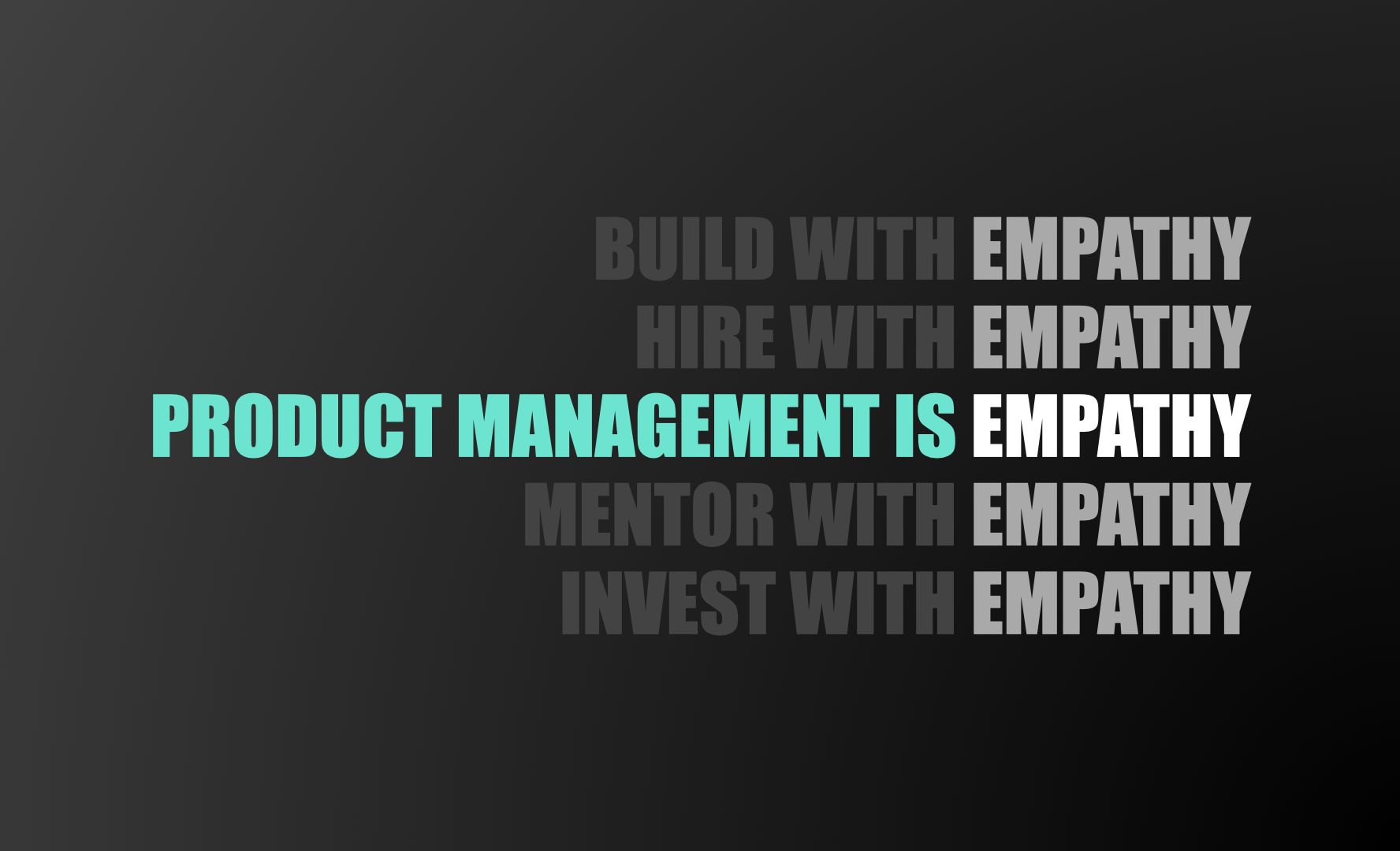Technology can bring us together — we always knew that. But now we know that technology can also tear us apart.
As the tech industry, we make the choice. We design technology to be a superpower or a source of human frailty.
At its best, building products is an expression of empathy. Empathy for everyone your product touches — the people that build it, and the people that use it.
Oxford defines empathy as “the ability to understand and share the feelings of another.” Empathy is putting yourself in another’s place.
This is the product builder’s job. You must put yourself in the place of all your product’s users — not just a single user or persona.
It’s a failure of empathy to collapse all users into a single persona. This failure led to “filter bubbles” on Facebook and other content platforms. A filter bubble occurs when an experience is designed to only show people the content they agree with. The Facebook News Feed is a filter bubble. Fox News and MSNBC are filter bubbles.
Filter bubbles are great for engagement. People love to engage with content that validates their feelings—that justifies their perspective. But these filter bubbles are a failure of empathy on two levels.
First, filter bubbles fail to create empathy in a product’s users. It’s hard to see things from another person’s point of view when all you see is your own.
Second, filter bubbles are the by-product of homogenous teams. It’s hard to see a filter bubble from the inside. The product teams at large tech companies are majority white, male, and liberal. The average PM at Facebook sees a News Feed that reinforces his world view—so does the PM sitting next to him, and so on.
In 2016, controversy erupted at Facebook when an employee crossed out a “Black Lives Matter” poster and replaced it with “All Lives Matter”. Facebook prides itself on allyship and inclusion. The fact that someone in their midst acted differently was a shock to the system.
There is an empathy story on both sides of the controversy. Facebook’s inclusion mindset is so intense that it can make people outside their ethos feel excluded. That said, I’ve never understood the “All Lives Matter” retort.
If “Black Lives Matter” makes you reflexively think “All Lives Matter", then you are blessed -- you've likely never experienced having your life's value evaluated differently than everyone else’s.
Put yourself in the place of the person who feels — due to the sum of their life experiences — that they must stake the claim: “My life matters.”
Empathy is the antidote. Put yourself in the place of the person who feels—due to the sum of their life experiences—that they must stake the claim: “My life matters.” No retort is needed.
Technology products are amplifying the human experience. Steve Jobs promised that computers can be “a bicycle for the mind”. In that way, technology has delivered. Today we are capable of so much more connection, creativity, and ingenuity than before.
Technology products are amplifying the human experience, but they are also distorting it.
But, unexpectedly, technology is also distorting the human experience. Too often, companies are designing products that encourage people to act in ways that are inhuman. Those products encourage us to binge, to turn relationships into streaks, to play until our hands and eyes hurt, and to value our own point of view to the exclusion of all others.
As product managers, we are at the forefront of determining how technology products shape our lives. We owe it to ourselves, our team, and our users to make empathy the guiding principle of our work.
George Floyd’s suffering is a call to empathy. Technology enabled us to see the truth in the brutal moments on that day and since. But technology has also created the bubbles and distortions that have reversed racial progress.
People should help in any way they can, but—most of all—they should help in the way only they can.
Product managers and leaders should help in the way only they can.
As product managers, we can effect change in technology products and companies. That may sound banal, but technology products have become the fabric of our lives.
We weave that fabric.
Build with more empathy.
Too often, companies build for themselves, not their customers. Companies focus on making revenue, not delivering value. They focus on time spent, not time well spent. They focus on users who pay the most instead of users who gain the most.
Too often, companies build for themselves, not their customers.
Candidly, these tactics and other growth hacks work. But we don’t yet understand the full extent of technology’s dark side. As one example, Juul—the “Apple” of e-cigarettes—has reversed a decades long trend of decreasing teen nicotine usage. How many people will die before the anti-nicotine movement counters the tide?
Build to make your customers happy in the long-run, not addicted in the short-run. Yes, binging is great for engagement metrics—until you burn people out.
Build to solve customer needs, not to optimize company metrics. If you solve customer needs, the metrics always follow.
Build for real people, not abstract cohorts and segments. A single customer conversation can be worth millions of points of data. It’s much more valuable to solve a problem deeply for one person, than it is to solve a problem shallowly for thousands of people.
Hire with more empathy.
Product management teams should be as diverse as the people they serve. Facebook, Google, and others have a diversity problem. They have committed to increased focus and increased transparency. Yet, this has done more to illuminate the problem than to fix it.
In engineering, there is a pipeline problem—there just aren’t enough minority candidates coming out of engineering programs. In product management, there is no pipeline problem. There is a diverse pool of talented candidates to tap into. I know this because I’ve tapped into that pool over the course of hiring nearly 100 PMs—many from underrepresented backgrounds.
In product management, there is no pipeline problem. There is a diverse pool of talented candidates to tap into.
I don’t believe companies should ever hire for the sake of diversity. Instead, they should hire with more empathy—for their candidates, their team and their customers. That will create more opportunity for everyone.
Hire people without prior experience, and train them to be the exceptional PMs of the future. Inadvertently, companies compound inequities of the past by seeking experience over talent.
Anyone with the right mix of passion and talent can become a great PM. I’ve hired exceptional PMs who were investment bankers, journalists, brand managers, veterans, and public servants.
Hire people who will empathize with your customers. Companies miss out when they treat their customers as numbers to be studied, rather than people to get to know. Twitter missed out on a vibrant community of Vine creators when they shut down the app (many of whom are top creators today on Instagram and YouTube). Google missed out serving millions of users when they shutdown Orkut, Google’s original social network that was beloved in Brazil and India.
Hire PMs who have a hunger to learn about new people. They will unlock massive opportunities in user growth, use case expansion, and international market development.
Mentor with more empathy.
Hiring is the final step in a long process of brining a more diverse range of people into the tech industry. The first step is mentorship.
Mentorship is the first step in a long process of bringing a more diverse range of people into the tech industry.
A friend of mine runs YouthCITIES, a non-profit focused on helping middle and high school kids from diverse backgrounds become the entrepreneurs and tech leaders of tomorrow. I had the honor of teaching for the program. I’ve seen 11 year olds develop, refine, and present ideas that could rival many seed stage pitch decks.
Many kids think building apps is the coolest thing ever, and PMs are almost as cool as superheroes (definitely not as cool as Tik Tok celebs though).
You can start with kids or mentor anyone you know who has the potential to understand real people’s problems and create empathetic solutions.
Invest with more empathy.
Just 1% of venture-backed founders are black. Nowhere is tech’s diversity problem more acute than VC investing. Earlier, I talked about compounding inequities. The VC industry is a vicious cycle of inequity—there is a lack of diversity in the VC hiring pipeline which leads to a lack of diversity at VC firms which leads to a lack of diversity in funded founders.
Yet, one of the largest areas of opportunity is serving a large, growing Internet population who has been underrepresented, undervalued, and under-served. VCs follow the money, so we’ve seen more investment in companies focused on diverse customers. Unfortunately, this focus on diversity hasn’t extended fully to the people who run those companies.
Investing should be a financially driven activity—investing for the sake of diversity is a form of charity. Investing with more empathy is a comparative advantage.
Investing with more empathy is a comparative advantage.
Underrepresented founders are more likely to find unique, untapped opportunities. Underrepresented founders are more likely to understand the diverse customers they serve. Underrepresented founders have had to fight harder for funding, so they’re more likely to have the grit and tenacity needed to succeed as VC-backed entrepreneurs.
Technology is no longer the default good we thought it would be. Design choices turn technology into a superpower or into Kryptonite. Building products can and should be an empathetic activity.
We should put ourselves in the shoes of the people whose lives are shaped by our products. We should build value from their perspective, not from our perspective.

